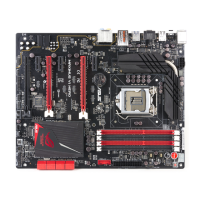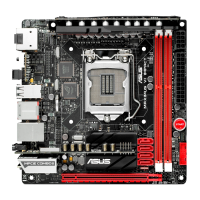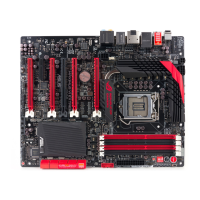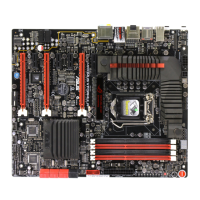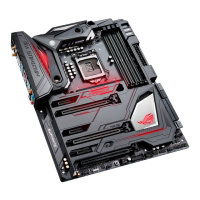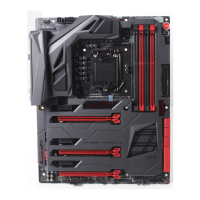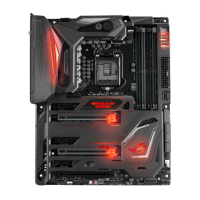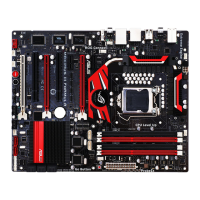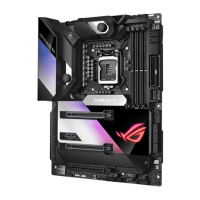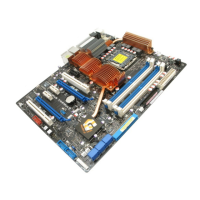Do you have a question about the Asus MAXIMUS VI FORMULA and is the answer not in the manual?
Highlights key features like CPU socket, chipset, and PCIe.
Details component layout, connectors, and jumpers.
Explains the types and configurations of PCIe slots.
Describes power, reset, MemOK!, and DirectKey buttons.
Information about the motherboard's diagnostic LEDs.
Details SATA, USB, fan, and power connectors.
Step-by-step guide for installing motherboard and components.
Procedures for installing the CPU socket and processor.
How to correctly install RAM modules into the DIMM slots.
Instructions for updating the motherboard BIOS using various methods.
Connecting external peripherals to rear I/O ports.
Introduction to BIOS, its functions, and importance.
How to enter and navigate the BIOS setup interface.
Accessing advanced configuration options for system tuning.
Detailed settings for overclocking CPU, memory, and voltages.
Configuring SATA modes (AHCI, IDE, RAID) and hot-plug support.
Managing boot order and startup options.
Accessing special utilities like EZ Flash and Secure Erase.
Procedures for updating the motherboard BIOS.
Information on supported OS and general installation guidance.
Details on the contents and usage of the support DVD.
An all-in-one utility suite for system monitoring and control.
Tools for automatic system optimization and performance tuning.
Wireless media streaming, remote control, and file transfer features.
HUD for FPS games showing sound direction and intensity.
Explains different RAID levels (0, 1, 5, 10) and their benefits.
How to enable RAID mode in BIOS setup for SATA configuration.
Steps to create a driver disk for RAID setup during OS installation.
FCC, IC, VCCI, and KC compliance statements.
Contact details for ASUS support and service centers.
| Non-ECC | Yes |
|---|---|
| Memory channels | Dual-channel |
| Memory slots type | DIMM |
| Number of memory slots | 4 |
| Supported memory types | DDR3-SDRAM |
| Maximum internal memory | 32 GB |
| Supported memory clock speeds | 1333, 1600, 1866, 2000, 2133, 2200, 2400, 2600, 2666, 2800, 3000 MHz |
| Processor socket | LGA 1150 (Socket H3) |
| Processor manufacturer | Intel |
| Compatible processor series | Intel Celeron, Intel Pentium |
| Intel® Core i3/i5/i7/i9 series | i3-4xxx, i5-4xxx, i7-4xxx |
| USB 2.0 connectors | 2 |
| Number of SATA connectors | 10 |
| Number of SATA II connectors | - |
| Number of Parallel ATA connectors | 0 |
| USB 3.2 Gen 1 (3.1 Gen 1) connectors | 1 |
| USB 2.0 ports quantity | USB 2.0 ports have a data transmission speed of 480 Mbps, and are backwards compatible with USB 1.1 ports. You can connect all kinds of peripheral devices to them. |
| USB 3.2 Gen 1 (3.1 Gen 1) Type-A ports quantity | 6 |
| Component for | PC |
| Motherboard chipset | Intel® Z87 |
| Audio output channels | 7.1 channels |
| Motherboard form factor | ATX |
| Windows operating systems supported | Windows 7 Home Basic, Windows 7 Home Basic x64, Windows 7 Home Premium, Windows 7 Home Premium x64, Windows 7 Professional, Windows 7 Professional x64, Windows 7 Starter, Windows 7 Starter x64, Windows 7 Ultimate, Windows 7 Ultimate x64, Windows 8, Windows 8 Enterprise, Windows 8 Enterprise x64, Windows 8 Pro, Windows 8 Pro x64, Windows 8 x64 |
| Supported storage drive interfaces | SATA III |
| Maximum resolution | 4096 x 2160 pixels |
| Parallel processing technology support | 3-Way CrossFireX, Quad-GPU SLI |
| LAN controller | Intel® I217-V |
| Wi-Fi standards | 802.11a, Wi-Fi 5 (802.11ac), 802.11b, 802.11g, Wi-Fi 4 (802.11n) |
| Bluetooth version | 4.0 |
| Ethernet interface type | Gigabit Ethernet |
| BIOS type | UEFI AMI |
| ACPI version | 5.0a |
| BIOS memory size | 64 Mbit |
| Cables included | SATA |
| Depth | 244 mm |
|---|---|
| Width | 305 mm |

